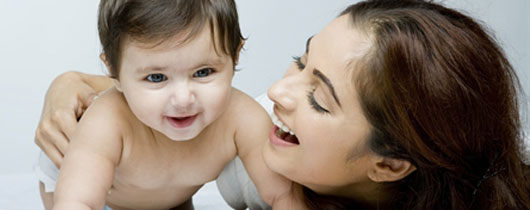Labour is usually divided into three stages: during the first, the uterus is contracting steadily to open up the cervix; in the second the cervix is fully open and the baby is pushed through the vagina and out into the world; in the third stage, the placenta, which is no longer needed to feed and give oxygen to the baby, separates from the wall of the uterus and is pushed out.

The first stage of labour
The cervix opens steadily during labour and it is possible to tell how labour is getting on by feeling the size of the opening and how quickly it gets wider. At the very beginning, the doctor can only get the tip of one or two fingers through the cervix, but afterwards she usually estimates the diameter of the opening in centimeters. The cervix is fully opened, or dilated, when it is about 10 centimeters in diameter. During the examination of the size of the opening, the doctor can also feel the position. The bones of the head are not joined together until many months after birth so it is possible to feel the separation between them. There are two places on the baby's skull where the bones do not meet. In the front is a diamond-shaped place where there are no bones, this is called the anterior fontanelle or 'soft spot' and a triangular area at the back called posterior fontanelle. When an examination is made through the cervix it is possible to tell whether the baby's face is pointing towards your spine or towards the front, this may be important during delivery. A vaginal examination will also show if there is plenty of room for the baby to come through the birth canal.
The first stage is the longest stage of labour, but it is shorter if you have already had a baby; even during your first labour it is very unusual for it to last longer than 24 hours these days; in most cases it is over within 12 hours.
The opening in the top of the pelvis is oval with the wider part of the opening extending from one hip to another. The baby's head enters the cavity with the face to one side; as it descends it swivels so that the head usually faces your spine and the shoulders can enter the pelvis.
The second stage
As soon as the cervix has opened fully, the uterus pushes the baby's head downwards into the vagina. At this stage the pressure of the baby's head gives you the feeling that you wish to push down and push the baby out. It is the same sort of feeling as straining to open your bowels, if you are rather constipated. During a push you will need to take a big breath, hold it, strain down, and push. It is very important that this should happen at the same time as a contraction of the uterus; the doctor will help you to time your pushing. It is during this stage that the baby swivels; the lower opening of the pelvis is another oval with widest diameter from front to back. The baby's head fills this, facing towards your back. A vaginal examination by the doctor will help to assess that the baby has turned into the current position.
The vagina expands to accept first the baby's head and then his shoulders. The crown, usually called the vertex, of the baby head appears at the entrance of the vagina and steadily expands the entrance. Sometimes the vaginal entrance is a bit too small to allow the baby's head to pass through easily. If this is so, the doctor will 'freeze' the area with an injection of local anaesthetic and then make a small cut, called an episiotomy, to let the baby's head emerge. This cut is sewn up when the baby is born.
The head comes through the entrance of the vagina, then the baby rotates again so that his face is sideways and each shoulder is towards the front or back. The shoulder that is towards your front is born first allowed by the other shoulder and then the rest of the body, which usually slips out easily. The hardest parts of the delivery are the birth of the head and shoulders.
The third stage
As soon as the baby has been completely born, the third stage begins. The uterus no longer contains bulky baby and the whole organ contracts. When this happens the placenta, or after-birth, is sheared from the inside wall of the uterus.
These days a contraction is often produced routinely by a drug called ergometrine which is injected into one of your veins or a muscle as the baby is born. The uterus pushes the placenta into the vagina and you may have another feeling of wanting to bear down. You can push the placenta out, but the doctor will usually pull it out by the umbilical cord.

